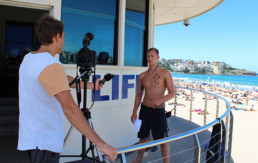Behind the Scenes at a Photoshoot
8 things you might not have known…
Ever wanted to know what really goes on on shoot day?
Whenever I tell a friend or family member I have am ‘on a shoot that day’ I often get met with ‘oohs and ahhs’ ‘your job is so exciting and glamorous’ etc.
Yes, it is very much a fun and rewarding process, but here are some insights you won’t necessarily see in ‘the Devil Wears Prada’…
- There is never enough time. You’d think getting five key shots in a day would be easy, right? But then when you have two models, a photographer, stylist, art director, client, limited light, outfit changes, product considerations – you can easily find it takes 1-2 hours to set up each shot, and then another 1-2 hours to get the perfect frame, when the product, lighting, model, mood, props are all exactly as required. Most shoots, by the end of the day I’m running against the clock and trying to keep my photographer and my client both happy, while making sure we walk away with the shots we need.
- A clear brief goes a long way to success. Sometimes I spend weeks researching shot angles, propping, styling, lighting – get it all approved and ‘just so’ on the day and then the brief changes. This is quite difficult to manage as when there is a large team and limited time, there are a lot of moving parts that can get held up by a brief change. We can always work on the fly but we risk not getting any amazing shots while we flounder to switch it all around.
- You have to let the magic happen. Some of the best shots I have been a part of getting in my career have been accidents. Some of the best designs too. On the day, sometimes your best bet is to hire the people you trust and then just let them do their thing. You might be surprised at how amazing the results can be if you don’t try to micro manage the process.
- It is exhilarating, fun and exhausting. Photographers, stylists, creative directors, models and clients coming together for a day of intense team work is often a relatively rare experience and one to be cherished and enjoyed.
- Preparation is key. Example shots, compositions, framing, propping, styling, poses, expressions, lighting, colouring. When I do my prep work, n the heat of the moment when nothing is working and the client, photographer and models are looking to me for some direction – that is when I pull out my mood boards. If I’ve done my prep work right I can nearly always find something to reference to try a new way. There’s no point beating a dead horse if something isn’t working, and sometimes you just need to pull stumps on a setup and try a new approach entirely.
- It’s a team sport. Each member of the team is crucial and capable of making or breaking the shoot. I am so fortunate to have worked with some amazing talents over the years who have made the potentially high stress pressure cookers that is a shoot a dynamic and fun experience.
- Things don’t always go to plan, and that is okay. That’s why you hire professionals, so we can use our experience to manage when things go wrong and still walk out with great shots.
- It’s quite technical. Forget what you’ve seen in Zoolander. A lot of the time, we’re shooting for a specific scenario. It’s pretty rare that you’ll be shooting for a full page advertisement in a glossy magazine with no text these days. For example, shooting for delicious magazine banner ads we set up overlays in the preview so we could see immediately how the shot would crop for long skinny banner advertisements and tall wide ones. In the luk beautifood shoot we set up masks for the preview so we could see exactly what parts of the image would be visible when used to wrap the lipsticks. And that’s not even mentioning the technical expertise that goes into getting the lighting, focus and food styling all right!
- The results make it all worthwhile. Yes, it is expensive. Yes it can be stressful. But at the end of the day I have never had a client regret it once they have a set of unique, beautiful, perfect shots that are completely their own, that no one else has anything like. There’s no better way to completely capture your brand than shoot your own images.
Get Your Idea Out There, Today.
We’ve come to a point where online entrepreneurship is easier than ever. People with great ideas can now realistically put those ideas into play without having to reverse mortgage the house or stump up with hundreds of thousands of dollars.
Obviously that doesn’t mean success is a given. “Making it” is as hard as ever. Given lowered barriers to entry, your incredible idea has definitely already been thought of, but as yet, probably hasn’t been executed well enough to become a “thing”. The adage that in business 1% is the idea and 99% is the execution holds true more than ever before.
In 2015, ideas are cheap. Execution is everything. Friendster becomes MySpace becomes Facebook in less than a decade. Almost the exact same idea; different execution.
So, how do you determine if your idea is a winner?
There’s so much great theory to help you bring your ideas to life and test them in the market. If you’re starting an online business and you don’t know about Lean Startup, Eric Ries (B2C businesses) or Steven Blank (B2B businesses) you need to stop everything and hit Google straight away. Before you do anything else get familiar with their work, and become intimate with the term “Product / Market Fit”. Everything you do as a startup from day 1 should be bringing you closer to determining if there’s a market for your product (service / idea) without wasting time, money or other resources.
The best way to test your ideas fast is to buy traffic
Even today, here at Label, we’re surprised by the number of fantastic ideas that cross our desks where incredibly talented entrepreneurs think that just putting their ideas online, even with an expensive website, will lead to a gold rush. In 2015, great ideas are a commodity. A great idea, backed by laser focussed execution is unstoppable. Poor execution fails a good idea every time.
A simple way to test whether you’re close to achieving product / market fit is to send people to your site and see if they behave as you expect them to. In an eCommerce business, this is easy: do people buy anything when they visit your site.
In 2015, the easiest and quickest way to get people to your site is to buy traffic on a pay for performance basis.
Pay for Performance
Slowly dying are the days of advertising where you pay for “reach”: a publisher or media company tells you how many people they reach, and you pay for an ad that apparently reaches each and every one of those people, regardless of whether they display a preference to find out more about your product or service.
Online, the advertising model that makes most sense for startups is one where you only pay for qualified traffic: people who have indicated some preference for your product or service by clicking on an ad about it.
This model of advertising gives the entrepreneur a great toolkit to send at least partly qualified traffic to their sites and only pay for people who arrive.
In a later post, we’ll be looking at how to measure success with Pay for Performance media in an eCommerce business.


